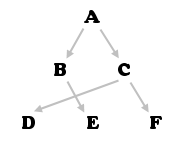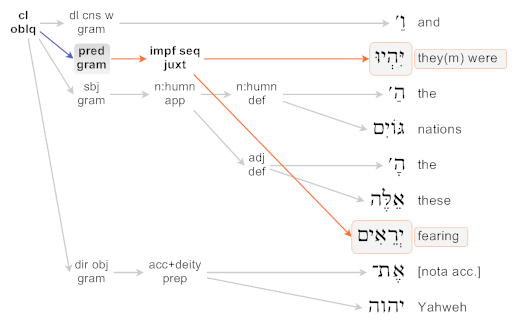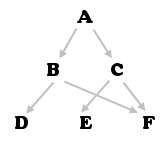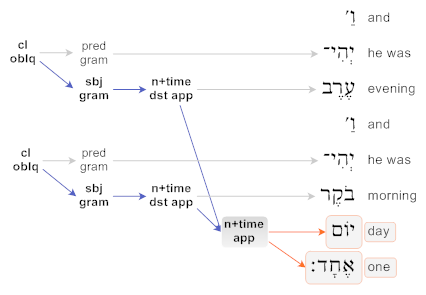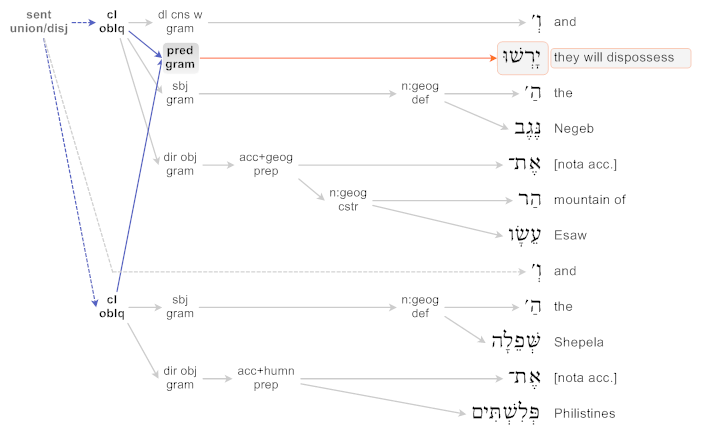https://www.logos.com/grow/wp-content/uploads/2005/11/syntax_andersen.html Consider the simple graph to the right. A graph, you will recall, is a diagram made up of labels and lines. This particular graph has some further special characteristics: (1) This is a directed graph, because the lines are arrows that indicate which labels are “on top,” so to speak; if this were a corporate organization chart, the arrows would always point from manager to employee. (2) This graph is acyclic, which is a fancy word meaning “no cycles,” which is a fancy way of saying that if you follow the arrows in the direction they are pointing, you will never visit the same label twice. Put another way, if no matter where you start, you will eventually reach the end. (3) This particular graph is a tree, because it has exactly one topmost label (the CEO in our org chart), and each label has one and only one arrow that points to it. That is, each employee has only one boss — wouldn’t that be nice?
I think that I shall never seea graph as lovely as a tree.
The trouble with trees is that they are too simple and neat. Natural language, on the other hand, just isnt. Real-life sentences are filled with all sorts of quirks, some of which cannot be expressed as a strict tree. Which is precisely why we must sometimes use graphs and not trees. Ill use two phenomena from the Andersen-Forbes Hebrew phrase markers to illustrate the point: Tangling and multi-dominance.
Oh, what tangled webs we weave.
Sometimes, words that belong to the same grammatical or syntactic structure are broken up and cast to the far ends of the sentence. In the sentence, I would like to quickly, if at all possible, address the issue of split infinitives, the infinitive to address is split. (My sixth-grade English teacher would be appalled, by the way. Im sure she wouldnt approve of my writing a split infinitive ever, even to illustrate a point.) That happens sometimes; if youre going to make a sentence, you have to break a few syntactic structures now and then. Its a fact of nature.
There are a couple of possible ways to handle this: Either you rearrange the sentence so that all the parts of the structure are next to each other, or else you keep the sentence in its original order and let the tree get tangled up. The Andersen-Forbes database opts for the latter, and I concur.
For example, in 2 Kings 17:41, the compound verb they were fearing is divided up in the verse:
We could rearrange this graph so that none of the lines crossed, but that would lose information. Because of the tangles, we can tell instantly, just by looking at the graph, that this predicator is not only a compound verb, but that the two parts of that verb are split apart. (By the way, this construction, where the subject of a clause splits a compound predicator with the verb of existence HYH in the first half, occurs eight times: Ge 15:17; 42:35; 1Sa 7:10; 2Sa 8:15; 1Ki 20:40; 2Ki 17:41; Isa 30:20; and Ezra 4:4. How did I know that?)
F has too many immediate supervisors.
If you look carefully at the example graph at left, youll see that the label F has two arrows leading into it. If this were a corporate org chart, then both B and C would be Fs immediate supervisors. This sort of thing happens now and again in the Andersen-Forbes syntax markup of the Hebrew Bible. (It also happens in software companies, but Im not bitter or anything.)
Whenever a structure modifies two or more parent structures, the A-F graphs reflect it with multi-dominance. For example, in Genesis 1:5, It was evening and it was morning, day one, the noun phrase day one modifies not only the first clause (it was evening) but also the second (it was morning). In effect, day one belongs to both clauses, because it modifies both evening and morning. You might say that its understood that day one modifies both clauses, so theres no need to say it the first time: It was evening [day one] and it was morning, day one. Heres what that looks like:
Thus, we would say that the noun of time day one is multi-dominated that is, it is dominated (or bossed around, to carry our org chart metaphor on a little further) by multiple other entities.
A similar thing happens in Obadiah 19, where the ESV reads, Those of the Negeb shall possess Mount Esau, and those of the Shephelah shall possess the land of the Philistines. NASB95 at that same verse reads as follows: Those of the Negev will possess the mountain of Esau, and those of the Shephelah the Philistine plain. Notice that the ESV repeats the verb shall possess, where NASB95 doesnt.
The syntax graph makes it clear why:
Get it? Follow the blue arrows back: The verb they will dispossess is a constituent of two clauses. Its multi-dominated. There are two pairs of dispossessors and dispossessees in this verse, but the verb is only explicitly stated for the first pair (Negev/Esau) and not for the second (Shephelah/Philistines). The NASB95 follows the Hebrew structure exactly, not repeating the verb, where the ESV supplies the verb a second time for clarity.
So, whats the point? Only that natural language is complex, and that a graph is a reasonably good way to capture and display that complexity. Traditional sentence diagrams, flow diagrams, and even linguistic tree diagrams fall short, but graphs do a pretty good job.
Next, a look at the Andersen-Forbes database in its particulars: What it marks up, how, and why.


